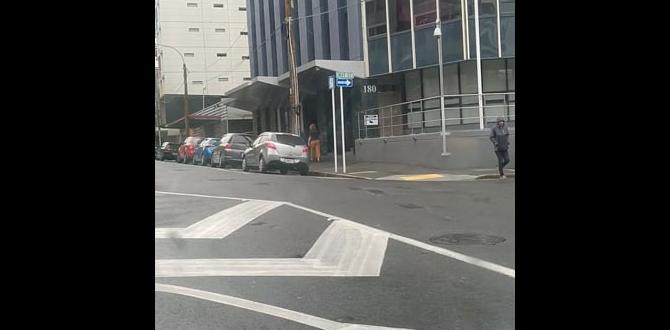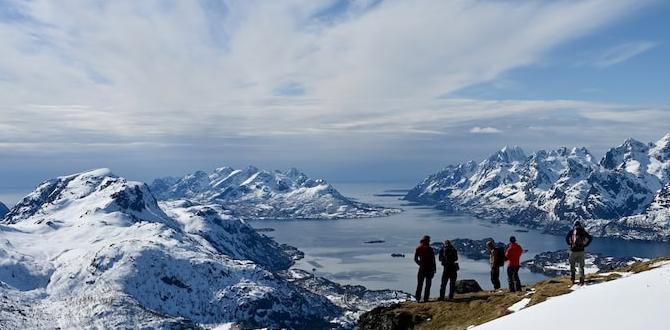Basque Country Instagram Spots: Your Essential Guide to Picture-Perfect Views. This guide unveils the most stunning, shareable locations in the Basque Country for your Instagram feed, from vibrant cityscapes to dramatic coastlines, with tips to capture them even without the crowds.
Planning a trip to the Basque Country is exciting! You’re ready for delicious food, beautiful scenery, and vibrant culture. But you also want those amazing photos to remember your trip and share with friends. Sometimes, the most popular spots are packed, making it tough to get that perfect shot. Don’t worry, I’ve been there! This guide will show you the best Basque Country Instagram spots, with simple tips to capture them like a pro, even if you’re looking for Basque Country Instagram spots without lines. We’ll explore hidden gems and smart ways to visit popular places.
Why the Basque Country is an Instagram Dream
The Basque Country is a visual feast. It offers a unique blend of modern architecture, ancient traditions, and breathtaking natural beauty. From the Guggenheim Museum in Bilbao to the charming fishing villages along the coast, there’s a photo opportunity around every corner. This region’s distinct culture, mouth-watering pintxos, and stunning landscapes make it a highlight for any traveler. Capturing these moments is part of the fun, and with a little planning, you can fill your feed with unforgettable images.
Best Basque Country Instagram Spots: A Visual Journey
Let’s dive into the most photogenic places that will make your Instagram followers swoon. I’ve organized these by region to help you plan your itinerary.
Bilbao: Modern Marvels and Riverside Charms
Bilbao is known for its striking contemporary architecture, making it a fantastic place for urban photography.
Guggenheim Museum Bilbao
This iconic museum, designed by Frank Gehry, is a masterpiece of modern architecture. Its shimmering titanium facade changes color with the light, offering endless photographic possibilities. Don’t miss the surrounding sculptures, especially “Puppy” by Jeff Koons.
- Best Time for Photos: Early morning or late afternoon for softer light and fewer crowds.
- Angles to Capture: The main facade from across the river, the boat-like structure from below, and details of the titanium panels.
- Tip: While the exterior is free to photograph, interior shots often require permission and may be restricted.
Zazpikaleak (Casco Viejo)
Bilbao’s Old Town is a labyrinth of narrow streets, colorful buildings, and lively squares. It’s perfect for capturing authentic Basque life.
- Must-See: Plaza Nueva, Mercado de la Ribera, and the many small taverns with their vibrant pintxos displays.
- Hidden Gems: Look for ornate balconies, traditional signage, and intimate alleyways.
- Angles: Shoot upwards to capture the height of the buildings, or find a vantage point in Plaza Nueva to capture the buzzing atmosphere.
Paseo Peatonal de la Ría de Bilbao
This riverside promenade offers fantastic views of the Guggenheim and the city’s bridges, including the striking Zubizuri Bridge designed by Santiago Calatrava.
- What to Photograph: The bridges, the reflections in the river, and the city skyline.
- Walking Tip: Take your time strolling along the riverbank. Different viewpoints offer entirely new perspectives.
San Sebastián (Donostia): Beaches, Belle Époque, and Breathtaking Bays
San Sebastián is famous for its stunning crescent-shaped bay, elegant architecture, and world-class culinary scene.
La Concha Beach & Promenade
Often cited as one of Europe’s most beautiful urban beaches, La Concha is a postcard-perfect spot. The elegant promenade is ideal for capturing the golden sand, turquoise waters, and the iconic “
Isla de Santa Clara
.”
- Photo Opportunities: The promenade itself, the beach with the island in the background, and the elegant lampposts lining the walkway.
- Best Time: Sunrise for serene beauty, or sunset for warm, golden light.
- Tip for Fewer People: Walk further along the promenade towards Ondarreta beach, or visit during weekdays outside of peak summer months.
Monte Urgull & Monte Igueldo
These two hills offer panoramic views of the city and the bay. Monte Urgull has a historic castle and is a bit wilder, while Monte Igueldo features a charming old amusement park.
- Monte Urgull Highlights: The Castillo de la Mota, the Sagrado Corazón statue, and viewpoints overlooking the Old Town and the sea.
- Monte Igueldo Highlights: The vintage amusement park (especially the funicular ride!), the Torre de San Sebastián, and sweeping views of La Concha.
- Tip: The views are spectacular at any time, but sunset from Monte Igueldo is particularly magical.
Parte Vieja (Old Town)
Similar to Bilbao’s Casco Viejo, San Sebastián’s Old Town is a charming maze of cobblestone streets filled with pintxos bars, artisanal shops, and historic buildings.
- Must-Capture: The bustling streets, the lively squares, and the colorful pintxos displays.
- Unique Spots: Look for the Basilica of Santa Maria del Coro and the Church of San Vicente.
- Pintxo Photography: These culinary delights are highly photogenic! Capture a colorful spread to showcase the Basque food scene.
Kursaal Congress Centre
This striking modern building, with its glass cube design, stands out against the older architecture and offers interesting visual contrasts, especially at night when it’s illuminated.
- Best View: From the beach or the promenade opposite the building.
- Night Photography: The illuminated building against the dark sky is a fantastic shot.
Coastal Gems: From Fishing Villages to Dramatic Cliffs
The Basque coastline is rugged and beautiful, dotted with picturesque towns and dramatic natural formations.
Getaria
A charming fishing village famous for its grilled fish restaurants and its picturesque harbor. It’s also the birthplace of designer Cristóbal Balenciaga.
- Key Spots: The harbor with its colorful boats, the mole offering views back to the village, and the Balenciaga Museum.
- Photo Tip: Capture the boats bobbing in the water with the old town rising behind them.
Zumaia
This town is famous for its unique geological formations, particularly the flysch cliffs that jut out into the sea. Flysch is a sequence of different rock types, creating stunning layers.
For a truly unique photographic experience, visit the Basque Coast Geopark, which encompasses Zumaia. This UNESCO Global Geopark offers incredible opportunities to photograph the stratigraphy of the cliffs.
- Location: Explore the beaches of Itzurun and Santiago, where the flysch formations are most prominent.
- Best Time: Low tide can reveal more of the rock formations.
- Safety Note: Be mindful of tides and weather conditions when exploring the cliffs.
San Juan de Gaztelugatxe
This breathtaking hermitage, perched on a rocky islet connected to the mainland by a stone bridge, is an absolute must-see. It gained international fame from “Game of Thrones.”
Important Note: Access to San Juan de Gaztelugatxe often requires booking a timed ticket in advance, especially during peak season. This helps manage visitor numbers and preserve the site. You can check for updates and book tickets on the official Diputación Foral de Gipuzkoa website.
- Iconic Shot: The zigzagging stone path leading to the hermitage.
- Best Views: From the coastal path leading to it, or from nearby viewpoints.
- Tip for Fewer Crowds: Visiting on a weekday, early in the morning, or during the shoulder season (spring or autumn) can significantly reduce the number of people.
Inland Basque Country: Green Valleys and Traditional Towns
Don’t forget the interior! The Basque Country inland offers rolling green hills, traditional farmhouses, and charming villages.
Oñati and the Sanctuary of Arantzazu
Oñati is a historic university town, and nearby is the stunning Sanctuary of Arantzazu, a basilica set dramatically against a mountain backdrop.
- Arantzazu: Its modernist architecture, with impressive sculptures by Eduardo Chillida, makes it a unique photo subject against the natural landscape.
- Oñati: The old university building (Antigua Universidad) and cobblestone streets add a touch of history.
Elantxobe
This incredibly picturesque village clings to a steep hillside overlooking the sea. Its narrow, winding streets are a photographer’s delight.
- Unique Feature: The village is so steep that only the fire station has direct access by road and truck!
- Photo Challenge: Capturing the entire village often requires finding a viewpoint from the road above or below.
Tips for Photographing Basque Country Like a Pro
Even at the most popular spots, you can get amazing photos. Here are some practical tips that make a big difference.
1. Plan for the Light
The “golden hours” – the hour after sunrise and the hour before sunset – offer the softest, most flattering light. This is especially true for landscapes. Midday sun can be harsh and create strong shadows.
2. Beat the Crowds (Basque Country Instagram Spots Without Lines!)
This is key for many of these stunning locations. How can you achieve those serene, people-free shots?
- Early Bird Gets the Shot: Arrive at popular sites like San Juan de Gaztelugatxe or La Concha beach as early as possible, ideally around sunrise.
- Weekdays are Your Friend: If your schedule allows, visit popular destinations on a Tuesday, Wednesday, or Thursday. Weekends and holidays are always busier.
- Shoulder Seasons: Consider visiting in April-May or September-October. The weather is usually pleasant, and visitor numbers are lower than in July-August.
- Explore Further: Sometimes, just walking a little further along a promenade or a path can take you away from the main throng of tourists.
3. Look for Unique Angles and Details
Don’t just take a standard shot. Get creative!
- Get Low or High: Experiment with shooting from a low angle to make subjects look grand, or find a higher vantage point for a broader perspective.
- Focus on Details: Capture the intricate tile work on buildings, the textures of old stone walls, the vibrant colors of food, or the patterns in the landscape.
- Framing: Use elements in the foreground—like doorways, archways, or trees—to frame your subject.
4. Embrace the Weather
The Basque Country can be notoriously rainy, especially along the coast. Don’t let it deter you!
- Moody Skies: Dramatic, cloudy skies can add atmosphere to photos.
- Rainy Day Charm: Reflections on wet streets or the cozy atmosphere of a pintxos bar can make for beautiful, artistic shots.
- Waterproof Gear: For your camera, a simple rain cover or even a sturdy plastic bag can save the day.
5. Consider Your Gear (Keep it Simple!)
You don’t need professional equipment to get great shots. Your smartphone is likely more than capable!
- Smartphone Camera: Modern smartphones have excellent cameras. Learn to use its features like portrait mode, night mode, and panorama.
- Essential Accessory: A small, portable tripod is invaluable for low-light shots, long exposures, and getting yourself in the picture.
- Power Up: Make sure you have a reliable power bank for your phone or camera. You don’t want to run out of battery when you spot the perfect shot.
6. Utilize Local Transportation
Getting between these spots is part of the adventure. Consider scenic train routes or local buses. For example, the Euskotren connects Bilbao and San Sebastián, offering views along the way.
Comparing Information: Basque Coast vs. Inland Beauty
Here’s a quick comparison table to help you decide where your photographic focus might lie:
| Aspect | Coastal Basque Country | Inland Basque Country |
|---|---|---|
| Typical Scenery | Dramatic cliffs, beaches, fishing villages, sea views, modern coastal architecture. | Rolling green hills, mountains, valleys, traditional towns, farmhouses, forests. |
| Photographer’s Appeal | Iconic landmarks (Gaztelugatxe), stunning bays (La Concha), geological wonders (Zumaia flysch), charming harbors. | Serene landscapes, pastoral scenes, historic religious sites (Arantzazu), quaint village life. |
| Crowd Potential | High at major attractions (Gaztelugatxe, La Concha). | Generally lower, more peaceful exploration. |
| Best Lighting Conditions | Golden hour for seascapes; diffused light works well for cliffs. | Golden hour for rolling hills; midday can be good for valley shots if not too flat. |
| Iconic “Instagrammable” Spots | San Juan de Gaztelugatxe, La Concha Beach, Zumaia Flysch. | Sanctuary of Arantzazu, picturesque rural villages. |
Packing Essentials for Your Photo Adventure
While this guide focuses on where to take photos, having the right essentials can make your journey more comfortable, which often translates to better photos.
- Comfortable Walking Shoes: You’ll be doing a lot of exploring, whether it’s climbing steps to viewpoints or wandering through old towns.
- Lightweight Backpack: To carry your camera/phone, water bottle, snacks, and a light jacket.
- Portable Power Bank: Essential for keeping your phone or camera charged throughout the day.
- Waterproof Camera/Phone Case: Especially for coastal areas where spray or rain is common.
- Reusable Water Bottle: Staying hydrated is key for energy.
- Travel-Friendly Diaper Solutions (if applicable): For peace of mind on long travel days, ensure you have discreet, reliable adult or child diapers for comfortable, stress-free journeys. Brands like Depend or TENA for adults, or trusted brands for children, offer great absorbency and discretion. This allows you to focus on enjoying the scenery rather than worrying about comfort.
FAQ: Your Basque Country Instagram Questions Answered
Q1: What are the best months to visit the Basque Country for photography?
A: Spring (April-May) and Autumn (September-October) offer beautiful light, fewer crowds, and pleasant weather, making them ideal for photographers. Summer (June-August) is warmer but busier.
Q2: How can I get to San Juan de Gaztelugatxe?
A: You can drive and park (parking is limited and often paid), or take public transport. From Bilbao, take a Bizkaibus (line A3511 or A3524) towards Bermeo and get off at the San Juan de Gaztelugatxe stop. From there, it’s a scenic walk down to the site.
Q3: Are there any photo restrictions at the Guggenheim Museum?
A: Exterior photography is generally permitted for personal use. Interior photography rules can vary and may require permission or be prohibited in certain exhibitions. It’s best to check the museum’s official website for the most current guidelines.
Q4: What should I do if it rains heavily during my trip?
A: Embrace it! Rainy days offer unique photographic opportunities, like capturing reflections in the streets of the Old Towns, the dramatic moody skies over the coast, or the cozy interiors of pintxos bars. Have a waterproof camera cover or use your phone carefully.
Q5: How can I find “Basque Country Instagram spots without lines”?
A: This often means seeking out less famous viewpoints, visiting popular spots very early in the morning or late in the evening, or exploring slightly off the beaten path in towns and villages. Areas outside the main tourist hubs, like the smaller fishing villages or inland valleys, are generally less crowded.
Q6: Is it safe to explore the flysch cliffs at Zumaia?
A: While the formations are spectacular, safety is paramount. Always check tide times, wear sturdy footwear, and be aware of your surroundings. Avoid getting too close to the edge, especially after





